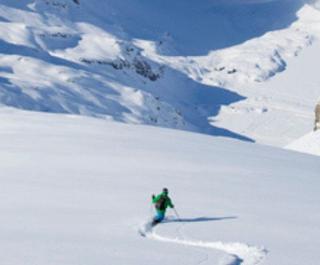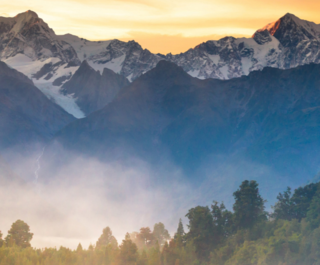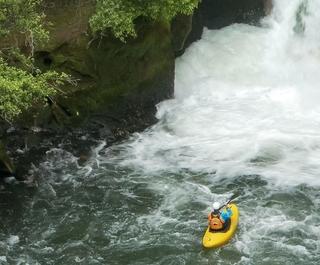
It’s when my “indestructible” stainless steel water bottle launches out of my daypack like a rocket, and smashes on the riverbed below that I realise just how perilous my situation has become.
I’m halfway up a cliff in the Sacred Valley of Peru, about an hour and a half north-west of Cusco, and the only thing stopping me from joining my smashed bottle below is a harness and a clip.
I know it’s enough to keep me safely tethered to the wall, but the sight of my water bottle gives me a sudden swirl of vertigo.
In front of me is a sheer rock face decked out with 400 iron rungs, part of a two-hour-long via ferrata climbing route that begins at an unmarked turn-off on Avenida Ferrocarril nine miles west of Urubamba.
 Suspended 400m above the Sacred Valley, near Cusco, Peru, the transparent Skylodge pods offer panoramic views. All photographs: Splash News/Corbis
Suspended 400m above the Sacred Valley, near Cusco, Peru, the transparent Skylodge pods offer panoramic views. All photographs: Splash News/Corbis
Via ferrata, Italian for “iron road,” is a climbing style that originated in the Alps that allows everyday climbers to navigate tough routes with the aid of rungs and a steel cable that’s fixed to the rock at strategic intervals.
This particular via ferrata includes what’s known as a “hanging bridge”. It looms up ahead as the latest challenge in what the Indian newlyweds who are climbing just ahead of me have described as an “adult obstacle course”.
The hanging bridge is nothing more than two parallel chords – one for feet, the other for hands – and it requires a leap of faith into a vertical position before shimmying over an abyss.
Fears conquered and bridge crossed, I monkey up the mountain for another half an hour under the watchful eye of my guide Americo Serrano
The higher we climb, the more the valley walls open up and reveal their treasures, including a smattering of crumbling Inca ruins hidden among the shrubs. We stop occasionally to admire the rare Andean orchids above or the increasingly miniaturised adobe village below before the strangest sight of all comes into view.
 Reaching ‘the world’s first hanging lodge’ involves climbing a via ferrata up the valley
Reaching ‘the world’s first hanging lodge’ involves climbing a via ferrata up the valley
Taste this nation's best. How To Taste The Best Of Peru
Join the hunt for the true lost city. In Search Of Paititi: Lost City Of The Incas
Nestled 400 metres up the cliff face like three translucent condor eggs is our destination for the evening: the Skylodge Adventure Suites.
Dubbed “the world’s first hanging lodge”, Skylodge has become a fixture on Pinterest travel boards and dream destination listicles since its debut in June 2013 – and it’s not hard to see why. It’s an audacious project located en route to one of the planet’s most visited man-made wonders: Machu Picchu.
The train to Machu Picchu comes choo-chooing along its tracks in the valley below just as I’m discovering my fishbowl in the sky – the “adventure suite” has 300-degree views over hills carved into sharp angles by the Urubamba river.
Each of Skylodge’s three octagonal capsules are made of aerospace aluminium and weather-resistant polycarbonate. Inside are four retractable tables, four solar-powered lights and plush beds (two singles and one double covered in mint green sheets and cloud-like duvets). There are also five windows that regulate the temperature and mitigate the funk of a day spent climbing.
 Inside a Skylodge pod
Inside a Skylodge pod
I find the loo in a space separated from the rest of the capsule by a thick canvas wall with a zip-up door. Inside is a washbasin with running water, a urinal and a dry toilet (a normal porcelain bowl with an abnormal plastic bag and chute system). There’s no shower, but it’s about as luxurious as you can get given the improbable locale.
Serrano tells me over dinner (quinoa salad, roast chicken and a chocolate cake that he carted up in his backpack, reheated and paired with a bottle of palatable Peruvian wine) that Skylodge is a one-of-a-kind project that could only exist in a country like Peru.
That’s because permissions and permits came long after the capsules were assembled and fastened to the valley wall with 12 anchors apiece.
It’s not that the capsules are unsafe – engineers have inspected all of the installations and they’re regularly evaluated by staff – but project manager Ario Ferri wasn’t going to let bureaucracy ruin his dream.
 Room with a view
Room with a view
“Ferri is a master welder who designed each of these capsules himself in his shop in Urubamba,” says Serrano, who was part of the team that spent two months lugging the three-part capsules up the mountain. “The goal was to take the concept of a hanging “portaledge” tent from the mountaineering world and turn it into something anyone could enjoy.”
Serrano climbs the ladder out of my capsule after dinner and shimmies over to his own pod for the evening. We’ll remain in contact by radio, but the night is mine to enjoy
The roaring winds that whip through the Sacred Valley each afternoon have died down.
No longer rattling, nor threatening to tumble down the hill, the capsule becomes a haven of tranquillity and a window to the night sky. Hundreds of twinkling stars, including those of the Southern Cross, appear so close on the far side of the transparent wall I feel as though I could reach out and pinch them.
Sleep, while suspended like a cloud in the sky, comes easier than imagined. And I need the rest. I’ve got seven hair-raising zip-lines to navigate before I touch down on solid ground tomorrow afternoon.
Visit your local Flight Centre store or call 131 600 for more advice and the latest deals on travelling to Peru.
This article originally appeared on guardian.co.uk
This article was written by Mark Johanson from The Guardian and was legally licensed through the NewsCred publisher network.![]()










